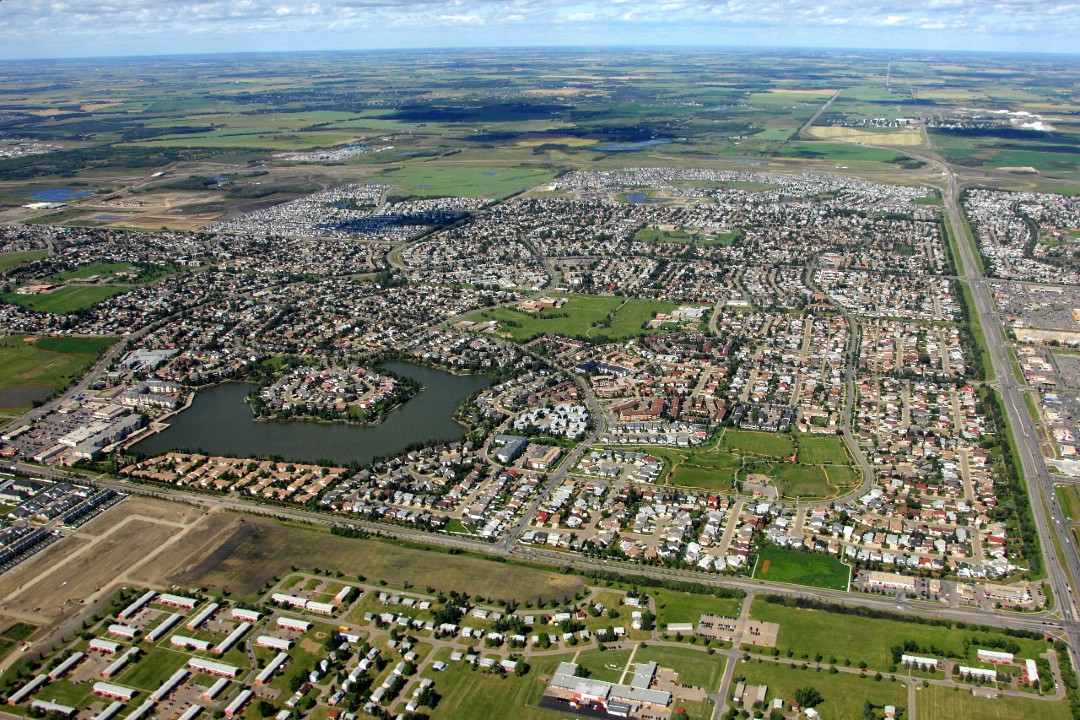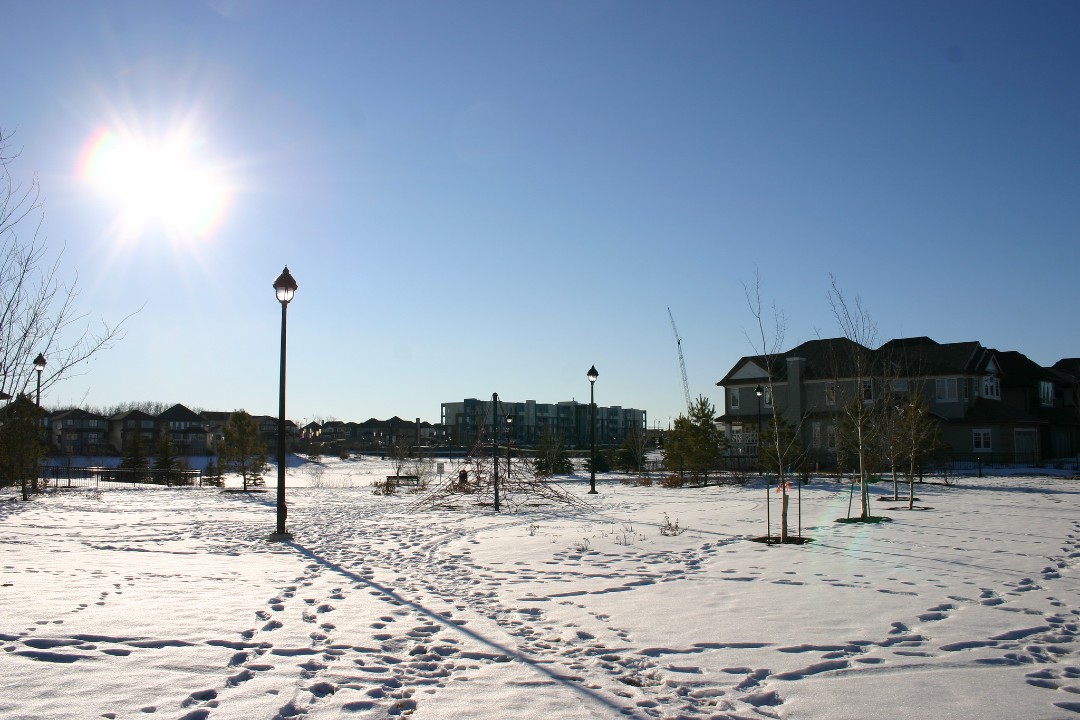With the next municipal election less than one year away, Edmonton is reckoning with an expected population of two million by as early as 2060 and a need to create housing to meet this demand. But how should Edmonton build to respond while keeping housing anywhere close to financially accessible? Out or in?
Growing out means sprawl, a practice of developing housing on undeveloped land at the edge of a city rather than adding it to existing areas. Sprawl has long offered Canadian home buyers the promise of driving until you qualify, meaning trading a longer car commute for a lower sale price.
"How far out can you go to find a house that you can qualify for a mortgage? That's essentially the idea, and generally, land on the outside of cities is less expensive than land in the centre of cities," Damian Collins, the leader of the Collins Lab for Urban Excellence, which is part of the Community Housing Canada research project at the University of Alberta, told Taproot. "So there's some truth to that."
Most Edmontonians live in housing located in a suburb that was once at or near the city's edge. Research shows that similar to Edmonton, 78.4% of Canadians are technically suburbanites. The Edmonton section of the Canadian Suburbs Atlas interactive map shows that the Edmonton region's more than 1.4 million residents live across different types of neighbourhoods, with 7.3% (102,882) living in the "active core," 12.1% (171,379) living in "transit suburbs," and the remaining 80% living in "auto suburbs" and "exurbs," which require a car to live comfortably.
Experts told Taproot there are trade-offs with how we build to meet future growth. Building housing through sprawl can lead to lower sticker prices for buyers but to higher living costs and higher overall property taxes. Growing through infill, conversely, can be more affordable overall, especially for taxpayers, but not all buyers will be satisfied — and sticker prices are often higher.
The City of Edmonton has shaped its planning to aim for half of new housing to be built inside the existing city, and half in greenfield sprawl.
Experts suggest getting the mix right is challenging.

When cities sprawl, travel costs go up for homeowners and taxes go up due to new infrastructure costs. Still, a great deal of Edmontonians prefer them, and there are several reasons why. (City of Edmonton)
A home's price is complex
Collins said when looking specifically at expenses, the full costs for different housing types are often left out of the discussion.
"Car ownership and use are completely required to actually live in those (outer) neighbourhoods," Collins said. "When you add up the cost of the mortgage, plus the cost of owning, operating, maintaining, and insuring those vehicles, you see that it's much more expensive than the sticker price of the house initially led you to believe."
But while land costs on the outskirts of the city are often lower than in established neighbourhoods, Katie MacDonald, a co-investigator on the Community Housing Canada project and an assistant professor at Athabasca University, told Taproot that some inner-city neighbourhoods buck the drive to qualify principle.
"You talk about how you can get a house cheaper in the suburbs than in the centre, but in my neighbourhood (of Alberta Avenue) you can get a house cheaper," MacDonald said. "In McCauley, you can get a house cheaper, but people don't want to live there because of the stigma now (for) downtown."
MacDonald added that infill housing in the Alberta Avenue neighbourhood is driving overall prices up. She said older houses in the area can list for about $300,000, whereas infill houses can list for as much as $800,000.
"It's really radically changing our neighborhood quickly," she said.
Sprawl costs us all
New sprawl neighbourhoods require the city to build essential services to connect them. Back in 2016, news reports noted a city discussion that its last three sprawling growth areas will ultimately cost the city $1.4 billion over 50 years, given it must upgrade streets, manage waste, provide policing, and build parks, fire stations, libraries, and recreation centres.
In September, Coun. Michael Janz cited this example when he wrote that sprawl costs money while infill earns it. In a separate post, Janz detailed a note from administration that showed infill in the University Heights neighbourhood had boosted property assessment values.
In line with keeping city costs in check, Edmonton's City Plan maps the future until 2050, including the expected population of two million, and the goal for a 50/50 split between infill and suburban development. In February, administration provided council's executive committee with a report that estimated Edmonton will now reach two million residents between 2060 and 2070, not 2050. The report also said infill rates in 2018 were 29% of development, but projected that will climb to about 85% by when the city hits two million.
The report said roughly 811,000 people currently live inside the Anthony Henday Drive ring road and that the city wants to welcome another 600,000 residents there. Without doing so, it said, Edmonton may need to annex another 5,000 hectares of land to provide sufficient housing in greenfield suburbs.

Most of Edmonton lives in a suburb, including greenfield developments on the edge of the city. Experts said these developments are in demand but also come with significant trade-offs for the city overall. (Mack Male/Flickr)
In June, the city floated a policy that would require "substantial completion" of existing neighbourhoods before new ones are built (but developers said this would increase prices). No decision will be made on the policy for at least two years. In October, the city passed its Zoning Bylaw Renewal Initiative measures after significant debate. Changes include increased density limits across the city.
Why many prefer the 'burbs
Policies and preferences are not always aligned.
MacDonald said one reason some might prefer housing built at the city's edge is that today's buyers often want more space, which developers are often building in these areas. She added that the way people see themselves as homeowners is also changing.
"Housing has come to mean something a little bit different to people," MacDonald said. "It's kind of moved into a conspicuous consumption piece that is really connected to identity, demonstrating a kind of class piece."
MacDonald, who used to work for Civida, also said there are other reasons people want bigger homes (though in the context of rental units). "We need way more units in Edmonton that are big. We know there's not enough units that have enough bedrooms for large families, for intergenerational families," she said. "When I worked in social housing, many large families would be on the wait list for a much longer time because it took so much longer for a unit that would fit their family, based on regulation, to come up."
Multigenerational living is more common in some cultures than others. Edmonton may need more housing that supports it as the population grows. In 2023, the city welcomed 47,100 international newcomers, up by 13,700 from the previous year.
MacDonald also pointed to "ethnoburbs" as potentially desirable places to live for Edmonton's growing, international-origin population. Unlike the centrally located Chinatown or Little Italy districts, ethnoburbs are suburban clusters that include both residents and businesses with a shared cultural background. Some examples of ethnoburbs include Richmond and Surrey in British Columbia, which are cities adjacent to Vancouver.
"Part of it is comfort and wanting to live near folks that (citizens who share a culture) know and love, and you have a lot of folks who have the same religious belief, for example," MacDonald said. "One of the things I think is really interesting happening in the city right now is often folks who are experiencing housing insecurity, who are immigrants or newcomers, they won't go to shelters or drop-in spaces, because they'll often go to their communities."
Whether it's in the suburbs or not, Collins said the city will need more purpose-built rentals to accommodate people from outside Canada who migrate to Edmonton.
"What the city and (housing) industry need to know about this population increase, especially with migration, is when people arrive in Canada, overwhelmingly, they rent," he said. "Very few people get off the plane and buy a house, because they don't have the money and they don't have any credit history in Canada."
Did the pandemic accelerate suburban growth?
Collins said housing choices changed during the COVID-19 pandemic, when urbanites escaped to the 'burbs and even rural areas. With some normalcy returning, though, Collins said he thinks this will reverse. "Cities draw people in with this kind of gravity that they have. My hunch is that we're not going to see really much long-term difference," he said.
Part of his skepticism comes from his observation that an increasing number of private and public sector employers are demanding more in-person work. Remote work is "not as accessible as it once was," he said.
There are consequences for the established city when people flee for the 'burbs, MacDonald said. During a recent stroll on 124 Street NW, for example, she said she noticed a high rate of business properties were up for lease, which she found disheartening.
"Because of sprawl and because of commuting and working from home, we're seeing this loss of culture and life in the downtown core, too," MacDonald said.
Next for Housing Complex
Taproot will examine what can be done to keep rental costs accessible in a future instalment of the Housing Complex series. Next up, however, is a look at what happened to public housing in Edmonton.

